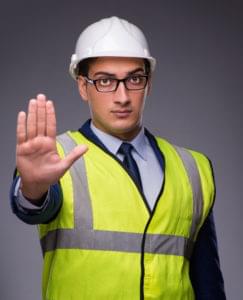Your workplace may not be as safe as you think, especially if certain common safety myths have infiltrated your work environment.
Even if you believe your workplace is extremely safety conscious, the truth is that we're all vulnerable to accepting incorrect or outdated information as being accurate. Often, we subconsciously consider change to be risky, and not worth the time or effort to implement. But that could mean you aren't considering a safety railing or other fall protection systems simply because they’re new and you've never done it that way before.

In the workplace, managers and long-time employees may have a specific way of thinking about safety based on their past experiences or what they've been told. For example, they may think that guard rails aren’t important because they never used them (or, in their minds, needed them). The problem is that these safety beliefs may be outdated, and just because they’ve been lucky in the past, doesn’t mean they always will be.
What can you do to bypass these incorrect beliefs about safety? Start by reviewing the myths below and discuss them in your safety meetings. Analyze which pieces of these myths rear up in your workplace, then take steps to banish them forever with new training, processes, and equipment — like adding a safety railing where it is most needed.
In many workplaces, employees (and managers) think using common sense alone is enough to keep people safe. Why would anyone do anything but take the utmost care when working near a leading edge? While that may make sense, it doesn’t account for trips, slips, and distractions, let alone the use of newer and more advanced tools and equipment.
Obviously, no one wants to get hurt. But you simply can’t hang your laurels on common sense when it comes to workplace safety. Installing safety equipment like guard rails simply eliminates the risk. Training workers properly and giving them the best safety equipment emphasizes that the company cares about keeping everyone safe.
What You Can Do: Install passive safety equipment like guard rails to keep workers safe. As well, you can adopt safety policies like those of Lockheed Martin. In a 2010 OSHA Challenge, the company's Fort Worth plant made a conscious effort to increase the number of safety and health self-inspections conducted by workers. This step helped the company identify and fix hundreds of hazards, resulting in 14 percent fewer injuries and illnesses. The company also estimated that they saved $574,000 through the initiative. Communicate to your workers what they need to look for and reward them for identifying safety hazards.
 2. It takes too much money to be safe.
2. It takes too much money to be safe.Just ask a workplace injury attorney about some of his or her more successful cases. You'll hear about millions of dollars being awarded to workers who were not properly trained or given the right fall protection systems to keep them safe on the job. Not only is an employee injured, but a resulting lawsuit can put a small company out of business or make a big impact on larger company's profits.
Then, there are OSHA fines that your company must pay if you're found to be in violation of health and safety regulations. Here are just a few OSHA proposed penalties related to fall hazards from July and August 2018:
The long-term safety view and the savings that you won't have to pay in lost productivity, employee hours, medical bills, fines and lawsuits outweigh the short-term savings of not investing in guard rails and other safety equipment and training.
What You Can Do: Immediately identify funds that could be used to correct some of the biggest issues in your company, such as a missing safety railing. Work your budgeting process to provide ongoing funding for safety equipment. Prioritize the identification of safety issues that can be corrected through new processes or equipment.
Workers who feel safe are free to be more productive without the nagging worry of protecting themselves and their co-workers. As Steve Powers, the Safety Programs Manager at Rockwell Automation, explained at a 2015 Safety Leadership Conference, workers afraid of getting hurt produce less. When they have fall protection systems such as a safety railing in place and a safe work environment is consistently emphasized, workers are free to work faster.
For example, let's take another look at Lockheed Martin, where supervisors at the Paducah, Kentucky, plant established a culture of workplace safety that focused on reducing accidents above almost everything else. They found that their factory costs decreased by 20 percent while workers gained a 24 percent increase in productivity.
What You Can Do: Work to make safety part of your workplace culture. That means indicating that safety measures are not a waste of time, and training managers and supervisors to emphasize safety even when it takes a few more minutes. Reduce the attention you pay to small deadlines and "time savers" that minimize safety concerns and more to planning and achieving larger deadlines.
This kind of fatalistic thinking needs to be replaced with an active mindset of seeking out and correcting possible safety violations. While you may not be able to eliminate every injury, you can reduce the severity of injuries and their impact on workers and project goals.
What You Can Do: Establish or review training protocols for jobs. Set up a program where workers are rewarded (time off or other small incentives) for identifying safety hazards. Eliminate any negative discipline related to spotting a hazard. Make sure management is encouraged to take training and identification of safety hazards seriously. And most importantly, install fall protection systems wherever there is a risk.
The job of identifying all potential fall hazards and keeping employees safe on a job site is the work of a safety manager, not OSHA. In fact, OSHA has what's called the general duty clause, which states your company needs to take responsibility for making sure the workplace is free of any issues that could cause injury.
While you may be meeting the requirements for fall protection according to OSHA, look for guard rails and other products that take extra steps to protect your workers.
What You Can Do: Consider OHSA requirements to be a bare minimum, and work with your supervisory staff as well as workers to identify areas where you can increase safety.
As an employer, one of your most important responsibilities is to keep your workers safe. That can mean re-examining some long-held beliefs. It can be challenging to reinvigorate your company culture to be consistently mindful of safety and to emphasize constant improvement. But the rewards of increased productivity and worker satisfaction — as well as decreased costs for OSHA fines, lost worker hours, and medical bills — can make the effort worthwhile.